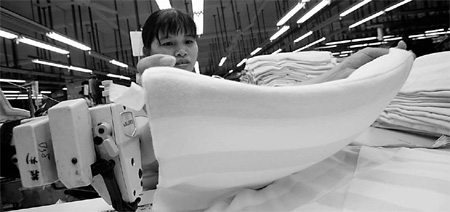|

|

A worker is seen at a garment factory in Ganzhou, Jiangxi province. The government is encouraging investors to explore opportunities in the central China region, a move that could stimulate economic growth in inland areas. Bobby Yip / Reuters
|
Government to offer incentives to bring capital, technologies, jobs to inland
The country's central region welcomes more new and hi-tech investments, a senior central government official has said.
"China will continue improving its investment environment and further open up its market in the central region to attract more investments from home and abroad," Vice-Premier Wang Qishan said at the Central China Business Summit 2010, part of the Expo Central China 2010, in Nanchang, Jiangxi province.
Earlier this month, the State Council released a document to accelerate the nation's industrial upgrade and the transformation of its economic growth mode.
As stipulated in the document, the central and western regions will be given preferential policies in finance, taxation, industrial investment, land use, commerce and trade, as well as science and education.
The Ministry of Land and Resources will give the region "preferential policies" in land use quota, Zhang Hongtao, chief engineer of the ministry, said on Saturday.
The central China region consists of six provinces located in the country's central hinterland, namely Shanxi, Anhui, Jiangxi, Henan, Hubei and Hunan, with a total area of 1.03 million square kilometers and a population of 370 million.
The area boasts abundant land and mineral resources as well as low-cost labor. It takes up one-fifth of the nation's aggregate economic volume but is also home to numerous traditional industries.
This year is the last year of China's 11th Five-Year Plan period (2006-2010). In August, as part of the plan to meet the proposed target of cutting energy consumption per unit of GDP production by 5.2 percent from 2009 to 2010, outdated production lines in 18 industries, including iron and steel, coke, ferroalloy, and calcium carbide, were ordered to close by the Ministry of Industry and Information Technology.
Henan shut down 230 factories and Shanxi 226 factories.
China's efforts in developing a low-carbon economy and the latest factory closures have given rise to widespread uncertainty in the future of traditional sectors such as manufacturing and the light and steel industries.
Still, a number of analysts have disagreed with this view.
"One of the most prevailing misunderstandings in upgrading industrial structure is that we should reduce the number of - or even shut down - our traditional industries," Long Yongtu, former secretary-general of the Boao Forum for Asia, said on Sunday.
"China is still at a primary stage of industrialization and urbanization, and it has a long way to go. So we should continue developing some labor-intensive industries such as manufacturing," Long said.
In receiving industrial transfers, the central China region should strive to move up the value chain but "never give up manufacturing and traditional industries", he said.He Qiang, director of the Institute for Securities and Futures at Central University of Finance and Economic, echoed Long's opinion.
"The so-called low-carbon economy is more than just about new high industries. It also includes developing those traditional industries to cut its energy consumption and greenhouse gas emission," he said.
The low-carbon economy is more of an economic growth mode "to reduce the energy consumption and gas emission through developing technology" and this applies to the traditional industries, he said.
China Daily
(China Daily 09/28/2010 page14)
|